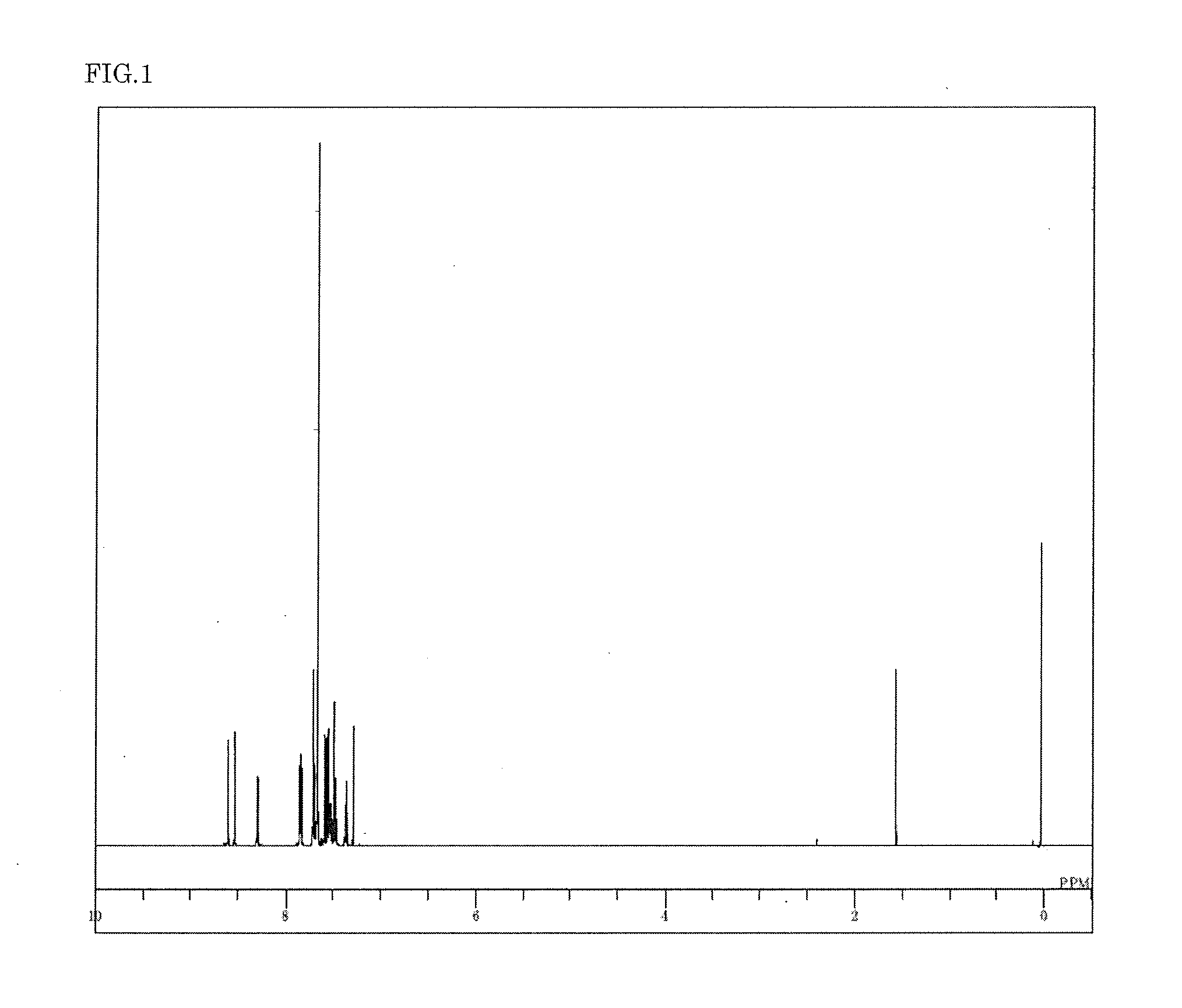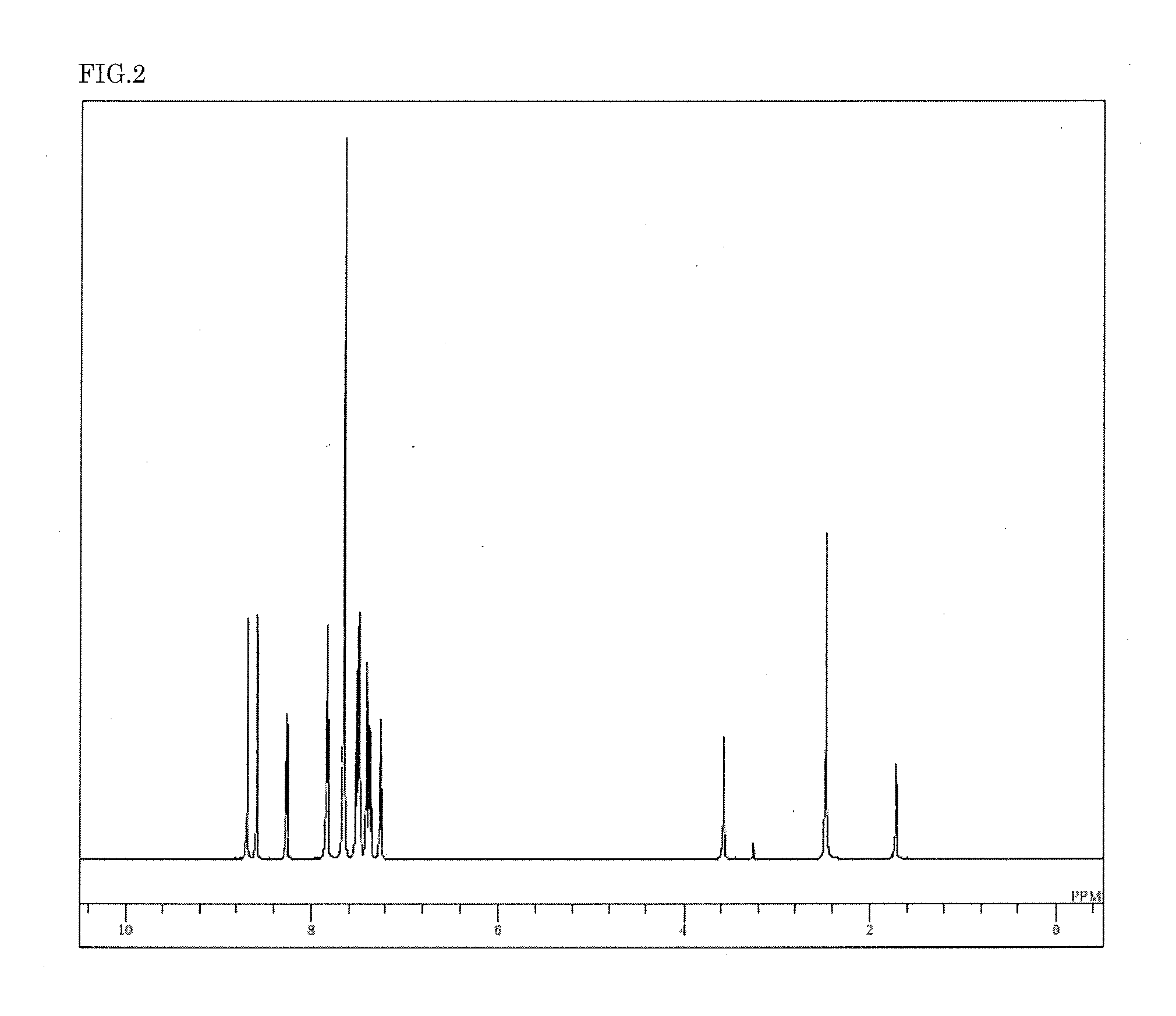Compound having carbazole ring structure, and organic electroluminescent device
a carbazole ring and ring structure technology, applied in the direction of solid-state devices, thermoelectric devices, organic chemistry, etc., can solve the problems of insufficient electron blocking performance of compounds, low hole mobility of tapc, and inability to improve luminous efficiency, etc., to achieve excellent triplet exciton confining capability, stable thin-film state, and heat resistance. excellent
- Summary
- Abstract
- Description
- Claims
- Application Information
AI Technical Summary
Benefits of technology
Problems solved by technology
Method used
Image
Examples
example 1
Synthesis of 3,6-bis[9′-(phenyl-d5)-9′H-carbazol-3-yl]-9-(phenyl-d5)-9H-carbazole (compound 11)
[0102]3,6-Bis(9′H-carbazol-3-yl)-9H-carbazole (2.4 g) synthesized by the coupling reaction of 3-bromocarbazole and 3-(4,4,5,5-tetramethyl-1,3,2-dioxabororan-2-yl)-9H-carbazole, bromobenzene-d5 (2.3 g), palladium acetate (77 mg), sodium tert-butoxide (1.65 g), and toluene (74 ml) were added to an argon-substituted reaction vessel, and aerated with argon gas for 30 min under ultrasonic irradiation. The mixture was heated after adding 0.3 ml of tri-tert-butyl phosphine, and stirred at 90° C. for 12 hours. The mixture was then cooled to 50° C., and 5 ml of methanol was added. The insoluble matter was removed by filtration, and the filtrate was concentrated under reduced pressure. The product was dissolved by addition of toluene (70 ml), and purified by adsorption using silica gel (7 g). After concentrating the product, methanol (50 ml) was added to precipitate the crystals. The crystals were p...
example 2
Synthesis of 3,6-bis(9′-phenyl-9′H-carbazol-3-yl)-9-(phenyl-d5)-9H-carbazole (compound 12)
[0105]3,6-Dibromo-9-(phenyl-d5)-9H-carbazole (26.1 g) synthesized by bromination after the coupling reaction of 9H-carbazole and bromobenzene-d5, 9-phenyl-3-(4,4,5,5-tetramethyl-1,3,2-dioxabororan-2-yl)-9H-carbazole (48.7 g), toluene (326 ml), ethanol (82 ml), and a 2M potassium carbonate aqueous solution (95 ml) were added to a nitrogen-substituted reaction vessel, and aerated with nitrogen gas for 30 min under ultrasonic irradiation. The mixture was heated after adding tetrakis(triphenylphosphine)palladium (2.23 g), and stirred at 72° C. for 6.5 hours. The mixture was then allowed to cool to room temperature. After adding methanol (650 ml), the precipitated crude product was collected by filtration. The crude product was dissolved by addition of toluene (1,130 ml), and purified by adsorption using a diamine silica gel (18.5 g), and then by adsorption using a silica gel (18.5 g). The product w...
example 3
Synthesis of 3,6-bis(9′-phenyl-9′H-carbazol-3-yl)-9-[4-(phenyl-d5)phenyl]-9H-carbazole (compound 54)
[0108]3,6-Dibromo-9-[4-(phenyl-d5)phenyl]-9H-carbazole (4.50 g) synthesized by bromination after the coupling reaction of 9H-carbazole and 1-bromo-4-(phenyl-d5)benzene, 9-phenyl-3-(4,4,5,5-tetramethyl-1,3,2-dioxabororan-2-yl)-9H-carbazole (7.06 g), toluene (67.5 ml), ethanol (17 ml), and a 2M potassium carbonate aqueous solution (14 ml) were added to a nitrogen-substituted reaction vessel, and aerated with nitrogen gas for 30 min under ultrasonic irradiation. The mixture was heated after adding tetrakis(triphenylphosphine)palladium (324.4 mg), and stirred at 72° C. for 8.5 hours. The mixture was then allowed to cool to room temperature. After adding methanol (130 ml), the precipitated crude product was collected by filtration. The crude product was dissolved by adding toluene (225 ml), and purified by adsorption using a diamine silica gel (3.5 g), and then by adsorption using a silica...
PUM
 Login to View More
Login to View More Abstract
Description
Claims
Application Information
 Login to View More
Login to View More - R&D
- Intellectual Property
- Life Sciences
- Materials
- Tech Scout
- Unparalleled Data Quality
- Higher Quality Content
- 60% Fewer Hallucinations
Browse by: Latest US Patents, China's latest patents, Technical Efficacy Thesaurus, Application Domain, Technology Topic, Popular Technical Reports.
© 2025 PatSnap. All rights reserved.Legal|Privacy policy|Modern Slavery Act Transparency Statement|Sitemap|About US| Contact US: help@patsnap.com



